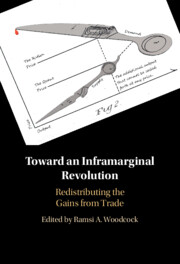Book contents
- Toward an Inframarginal Revolution
- Toward an Inframarginal Revolution
- Copyright page
- Contents
- Figures
- Tables
- Contributors
- Acknowledgments
- 1 Introduction to Inframarginalism and This Volume
- 2 A New Corporate Tax
- 3 The Progressive Case against Antimonopolism
- 4 An Inframarginalist Argument for Mandating the Use of Pro-Consumer Boilerplate
- 5 Inframarginalism and the Distributive Corollary of the Coase Theorem
- 6 Distributive Consequences of Regulating Boilerplate
- 7 (How) Does Competition Law Address Quality?
- 8 Self-Colonization in American Law
- 9 Taxing Imputed Land Rent
- 10 A Neo-Kantian Approach to Competition Law?
- 11 Is Commodity Private Property Inherently Regressive?
- 12 The EU Regulatory Patchwork for Dark Patterns
- 13 Inframarginalism and Economism
- 14 Hipster Antiplagiarism
- Index
1 - Introduction to Inframarginalism and This Volume
Published online by Cambridge University Press: 26 September 2025
- Toward an Inframarginal Revolution
- Toward an Inframarginal Revolution
- Copyright page
- Contents
- Figures
- Tables
- Contributors
- Acknowledgments
- 1 Introduction to Inframarginalism and This Volume
- 2 A New Corporate Tax
- 3 The Progressive Case against Antimonopolism
- 4 An Inframarginalist Argument for Mandating the Use of Pro-Consumer Boilerplate
- 5 Inframarginalism and the Distributive Corollary of the Coase Theorem
- 6 Distributive Consequences of Regulating Boilerplate
- 7 (How) Does Competition Law Address Quality?
- 8 Self-Colonization in American Law
- 9 Taxing Imputed Land Rent
- 10 A Neo-Kantian Approach to Competition Law?
- 11 Is Commodity Private Property Inherently Regressive?
- 12 The EU Regulatory Patchwork for Dark Patterns
- 13 Inframarginalism and Economism
- 14 Hipster Antiplagiarism
- Index
Summary
Progressives who respond to conservative law and economic arguments by rejecting neoclassical economic theory are making a mistake. Neoclassical economics is the only ideology that honors the modern view – associated with the Death of God narrative in Western culture – that there are no longer universal standards of value. To make a case for redistribution of wealth that appeals to the modern view regarding value – a view that progressives themselves hold – progressives must engage with economics. Fortunately, the concept of the gains from trade in neoclassical economics (also known as "surplus" or "economic rent") allows progressives to make a strong case for redistribution of wealth. That is because gains from trade can be redistributed without harming efficiency by varying the prices at which inframarginal units change hands. This insight is called "inframarginalism" to contrast it with the conservative view that the valuations of the marginal buyer and seller pin down price in competitive markets and therefore prevent redistribution of the gains from trade.
Keywords
Information
- Type
- Chapter
- Information
- Toward an Inframarginal RevolutionRedistributing the Gains from Trade, pp. 1 - 30Publisher: Cambridge University PressPrint publication year: 2025
Accessibility standard: WCAG 2.2 AAA
Why this information is here
This section outlines the accessibility features of this content - including support for screen readers, full keyboard navigation and high-contrast display options. This may not be relevant for you.Accessibility Information
Content Navigation
Allows you to navigate directly to chapters, sections, or non‐text items through a linked table of contents, reducing the need for extensive scrolling.
Provides an interactive index, letting you go straight to where a term or subject appears in the text without manual searching.
Reading Order & Textual Equivalents
You will encounter all content (including footnotes, captions, etc.) in a clear, sequential flow, making it easier to follow with assistive tools like screen readers.
You get concise descriptions (for images, charts, or media clips), ensuring you do not miss crucial information when visual or audio elements are not accessible.
You get more than just short alt text: you have comprehensive text equivalents, transcripts, captions, or audio descriptions for substantial non‐text content, which is especially helpful for complex visuals or multimedia.
Visual Accessibility
You will still understand key ideas or prompts without relying solely on colour, which is especially helpful if you have colour vision deficiencies.
You benefit from high‐contrast text, which improves legibility if you have low vision or if you are reading in less‐than‐ideal lighting conditions.
